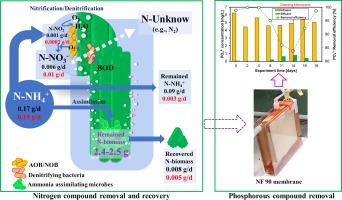一种基于光合作用的污水处理新策略
Q1 Environmental Science
引用次数: 0
摘要
光合作用为废水处理(WWT)提供了一种成本效益高且直接的方法,具有通过生物量积累回收养分的潜力。为了克服传统系统中生物质回收的挑战,本研究提出了微生物燃料电池(MFCs)处理后的光合作用后处理,利用聚丙烯纤维载体固定化生物质。这种方法减少了离心体积,提高了生物质回收率,并增强了污染物的去除。mfc -光合作用处理系统由两个相同的50 l光合作用反应器(F1和F2)组成,在污水处理厂安装,并分两个阶段运行了300多天:第一阶段是不受干扰的生物质沉淀,第二阶段是去除沉淀。在两个反应器中,NH4+的去除率高达99%,主要是通过第一阶段超过300 h的水力滞留时间(HRT)的光合微生物的同化和第二阶段的硝化作用,当HRT减少一半时。在hrt超过150 h时,两个反应器对化学需氧量和生化需氧量的有机物(OM)去除效率平均为70%和92%。采用纳滤工艺去除MFC和光合作用处理后残留的磷酸盐。使用商用NF90膜,该系统在1.3 mL/min的恒定渗透通量下实现了约99%的PO43 -去除率。对光合反应器中生物量的微生物分析发现,衣藻和蓝藻是优势属,在NH4+和OM的去除以及营养物到生物量的转化中起关键作用。总的来说,这种方法代表了一种可持续和有效的污水处理和资源回收战略。本文章由计算机程序翻译,如有差异,请以英文原文为准。

A novel photosynthesis-based strategy for improved sewage treatment
Photosynthesis provides a cost-effective and straightforward approach to wastewater treatment (WWT) with the potential for nutrient recovery via biomass accumulation. To overcome biomass recovery challenges in traditional systems, this study proposes a photosynthesis post-treatment following microbial fuel cells (MFCs) treatment, using biomass immobilized on polypropylene fiber carriers. This approach reduces centrifugation volume, improves biomass recovery, and enhances contaminant removal. An MFCs-photosynthesis treatment system, comprising two identical 50-L photosynthesis reactors (F1 and F2), was installed in a WWT plant and operated for over 300 days in two phases: phase I with undisturbed biomass precipitation and phase II with the precipitate removed. Up to 99 % NH4+ removal was achieved in both reactors, primarily through assimilation by photosynthetic microorganisms during phase I at hydraulic retention times (HRTs) exceeding 300 h and via nitrification in phase II, when the HRT was reduced by half. Organic matter (OM) removal efficiencies averaged 70 % for chemical oxygen demand and 92 % for biochemical oxygen demand across the two reactors at HRTs exceeding 150 h. A nanofiltration process was implemented to remove residual phosphate remaining after the MFC and photosynthesis treatments. Using a commercial NF90 membrane, the system achieved approximately 99 % PO43− removal at a constant permeate flux of 1.3 mL/min. Microbial analysis of the biomass in the photosynthetic reactors identified Chlamydomonas and Cyanobacterium as dominant genera, key in NH4+ and OM removal and nutrient-to-biomass conversion. Overall, this approach represents a sustainable and efficient strategy for WWT and resource recovery.
求助全文
通过发布文献求助,成功后即可免费获取论文全文。
去求助
来源期刊

Bioresource Technology Reports
Environmental Science-Environmental Engineering
CiteScore
7.20
自引率
0.00%
发文量
390
审稿时长
28 days
 求助内容:
求助内容: 应助结果提醒方式:
应助结果提醒方式:


